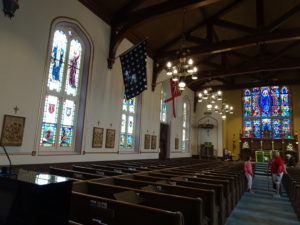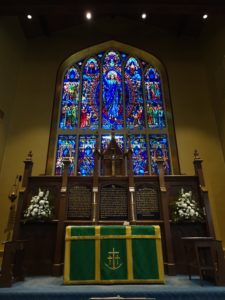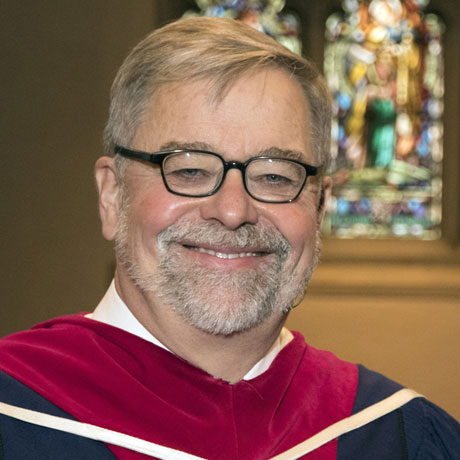Mariner’s Church

Gordon Lightfoot famously described Detroit’s Mariner’s Church as ‘a musty old hall in Detroit they call the Maritime Sailor’s Cathedral,’ but nothing would seem further from the impression it made on our pilgrims, many of whom at the end of our pilgrimage would refer to it as their favourite sacred space in Detroit. Regardless of where it may have ranked, one and all described it as a gem.

It should be no surprise The Mariner’s Church makes a lasting impression on Canadians for more reasons than Gordon Lightfoot’s mention of it in the Wreck of the Edmond Fitzgerald. Mariner’s Church sits at the entrance to the Detroit – Windsor Tunnel and is therefore the first building many Canadian’s see as they enter the United States at the second busiest border crossing between our countries. What’s more, among the eight flags hanging in the church, four trace their roots to Canadian or Commonwealth origins.

The Mariner’s Church was built in 1842 with a bequest of land on the Detroit River by Julia Ann Taylor Anderson to be consecrated for the construction for a non-denominational church where all sailors could worship freely. Sailors had often been shunned from churches in the port of Detroit.

The church was one of the first Neo-Gothic Churches in Detroit and is the oldest stone church in the city. However it was often referred to as ‘Perpendicular Gothic’ due to the placement of the Sanctuary on the third floor above street level. The first two levels were designed for commercial use to provide additional funds for the church. Through the early decades of the church’s life the lower level was also used as one of the last hiding places on the underground railroad for escaped slaves who would exit the church and cross the river to Canada. In the 1920’s and 30’s the lower levels were used as a charitable mission for the homeless and destitute who had reached the end of a different kind of road and for whom there was little hope. During these years there were few services in the Sanctuary as the sanctuary had literally become a shelter and the wooden pews beds for the homeless.
By the early 1950’s the church was no longer adjacent to the docks of the city and the sailors were gone. The poor of the 30’s had been off to war before returning to land jobs in the busy auto sector and moving to the suburbs. The Mariner’s Church was by then little more than ‘a musty old hall in Detroit.’ What’s more the city was expanding and Mariner’s Church was in the way and so its days seemed numbered until there arose a rallying cry to save the church. But saving Mariner’s Church also involved moving the 3,000 ton stone structure. In 1955 the church was jacked up onto four steel beams that were placed on rollers and over a period of a few months pulled and pushed and slid into place two blocks away.
Remarkably in its new place the first and second floors became the basement and the Sanctuary was at street level. A tower with bells was also added and beautiful stained glass. It may only have been after the remarkable move that the church became the sparkling gem it is today, but long before its last polish it was precious and all who benefited from its open doors could attest to that.
Throughout the Sanctuary there are countless symbolic references to the sea and the sailor’s life upon it as well as to Biblical references to the sea and of course the gospel accounts of Jesus stilling the storm upon the Sea of Galilee. There is also use of the historic imagery of the church as a ship and the nave of the church as the ark. The them mariner’s theme and use of Biblical imagery continues on the two lower levels where the Sunday School and Children’s Chapel are housed. The Children’s Chapel is a must see with its altar cloth decoratively stitched with Noah’s Ark, and also its child sized wooden pews.
A number of the maritime symbols and icons are obvious, but a closer look reveals hundreds if not thousands of smaller and more subtle references all of which serve to remind the pilgrim that though the signs of God’s presence are not always obvious in the midst of the storm, in moments of calm and quiet reflection we realize we are surrounded by God’s covering wings. As I considered the countless symbols I couldn’t help but think too of the countless hosts of struggling people whether slaves and sailors of the nineteenth century or the poor and homeless of the depression who found shelter in the time of storm at Mariner’s Church
The church’s link to the Edmond Fitzgerald began not with the Gordon Lightfoot song, but when the incumbent, the Rev. Rchard W. Ingalls upon hearing the news of the Great Lakes disaster went immediately to the tower to sound the bell 29 times in memory of the 29 officers and crew lost up river in Lake Superior. To this day the church hosts the annual Edmond Fitzgerald Memorial Service at which Gordon Lightfoot has often been a guest.
The Rev. Frank Bateman and the staff of The Mariner’s Church who offered us the warmest of welcomes continue to bear witness to the love of Christ to all who seek refuge from the storms of life.
One of our pilgrims, Rob Mee, a gifted musician and photographer has posted some absolutely remarkable photos of this sacred space along with the others we visited and can be viewed on his website at: https://focusonmee.com/detroit-michigan/
Grace and Peace,
Peter




